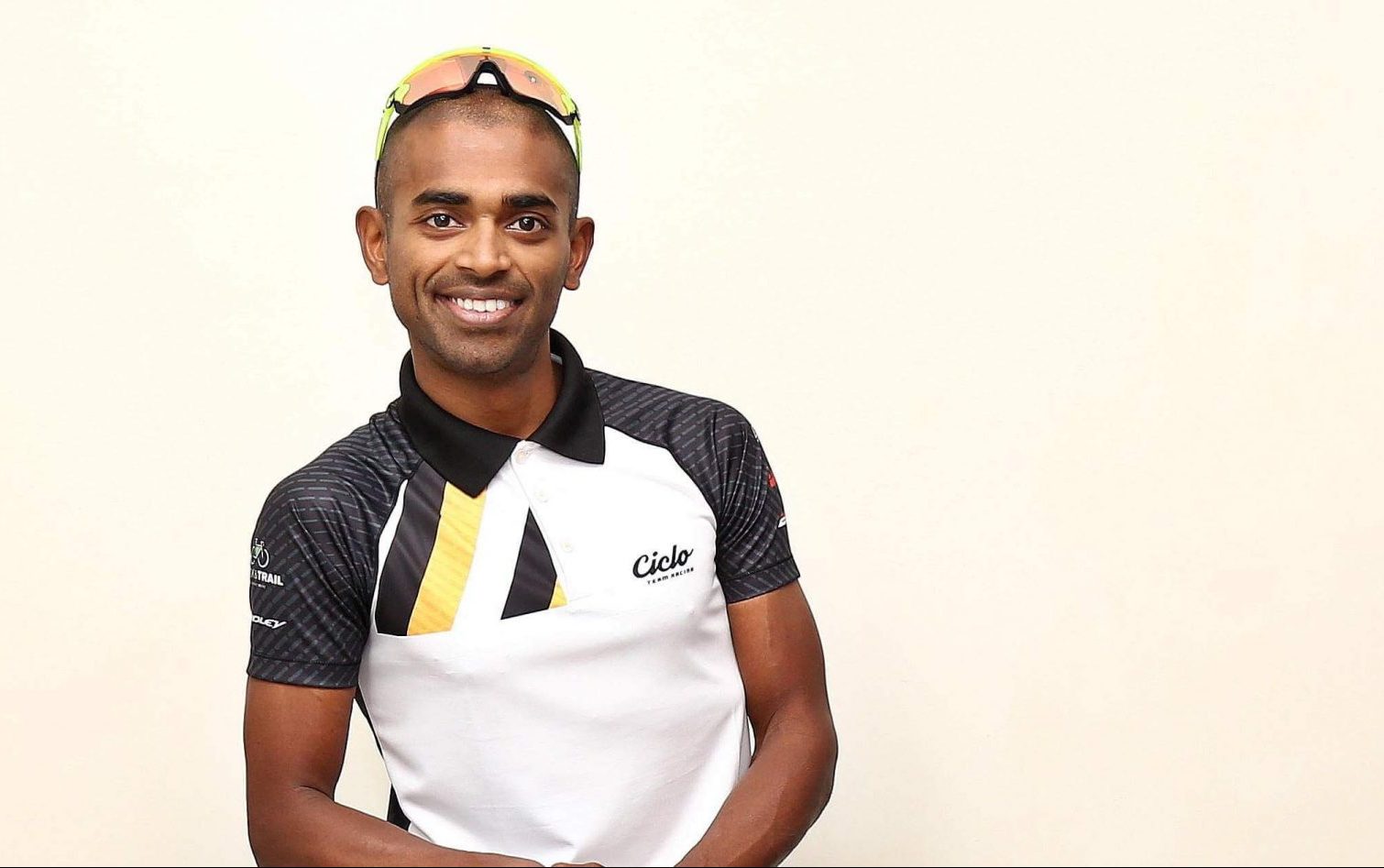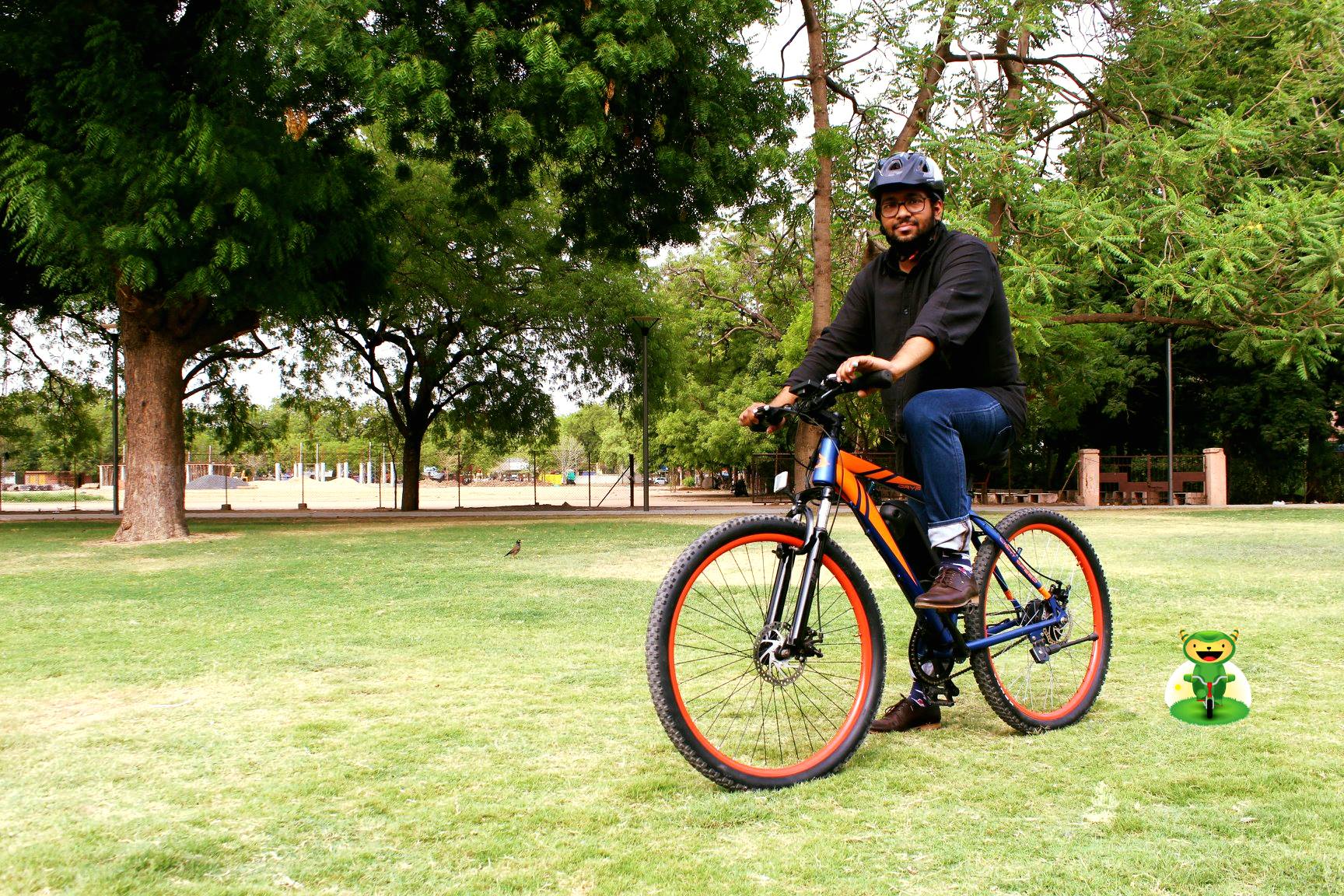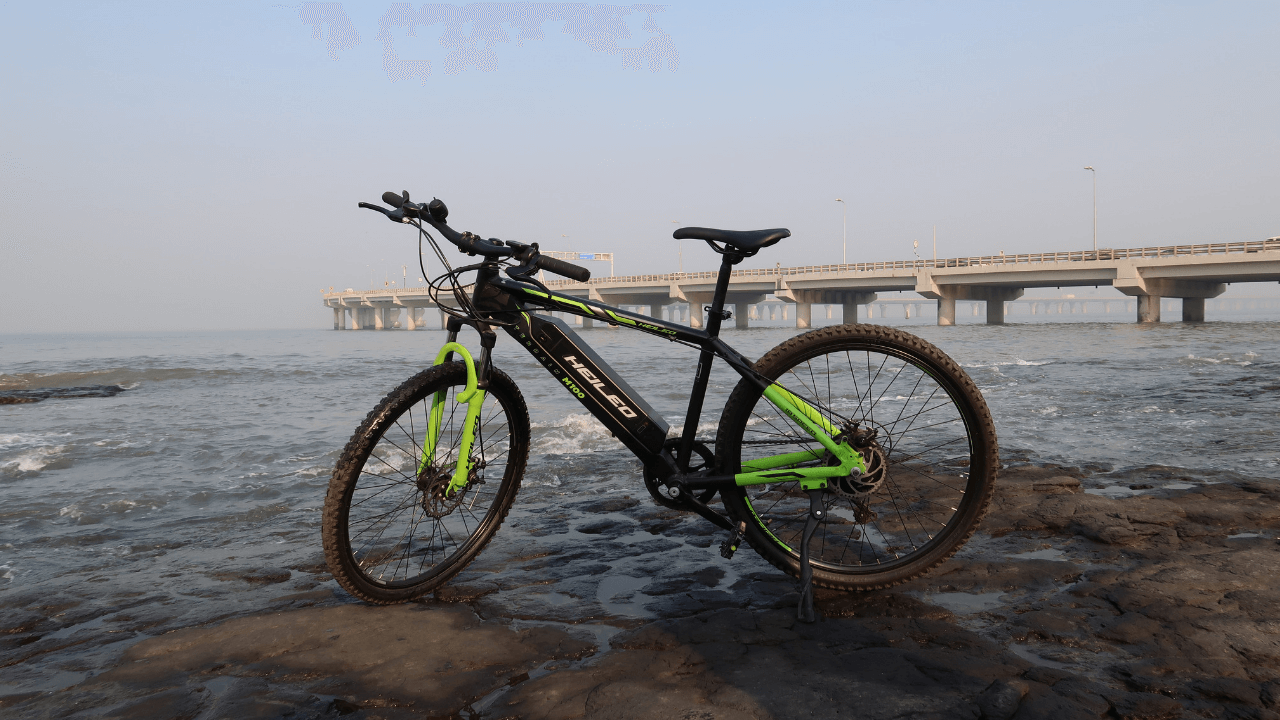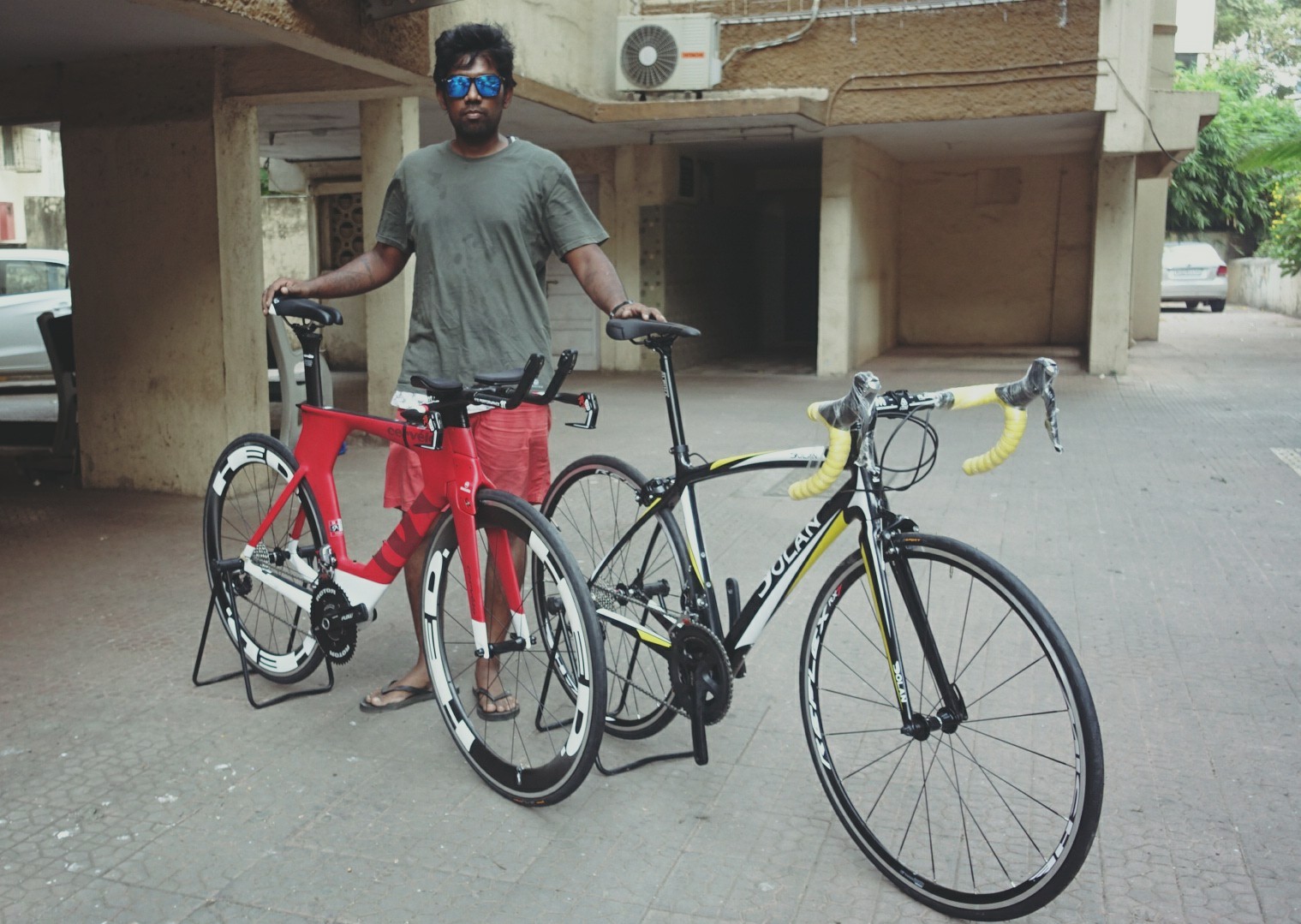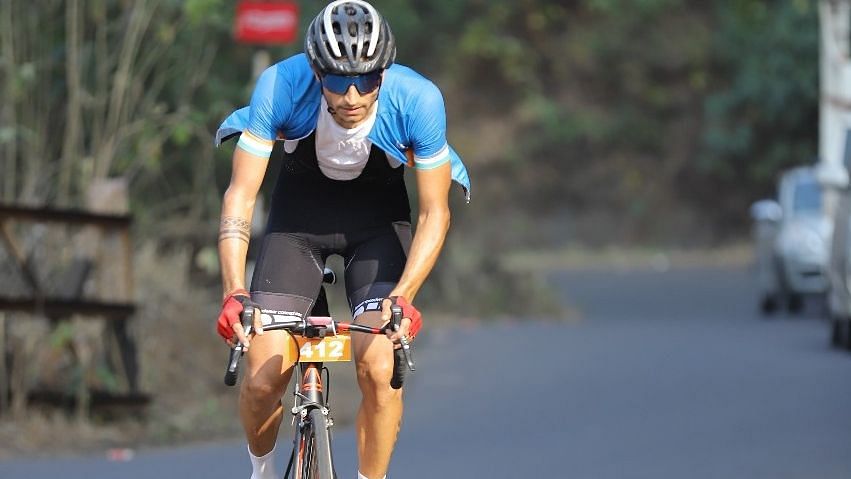There has been a sudden belief among Indian cyclists as our nation produced our very first International pro cyclist – Naveen John. We are not yet sure if we should rejoice or shed tears of sorrow. We are not yet convinced if this is good for Indian cycling or not. We feel we did lose a hero…

We recently had a Skype call with the current Indian National Time trial champ Naveen John who helped us clear the air. As an engineering student in the Purdue University, Naveen would often be cycling longer distances with his roomies. Racing and managing studies seemed to be his forte while he dreamt of racing for his nation, his motherland – India.
The story started when Naveen John got introduced to collegiate cycling when he was pursuing his Bachelors in Electrical Engineering at Purdue University. While in college, every weekend, Naveen and his roommates would drive across the mid-western US, load their bikes in a car, and head off to race the collegiate cycling calendar of events. Of course, they would carry their homework’s along, but that likely would lay catching dust.
Recently, Naveen John had the opportunity to serve as the president of Purdue University Cycling Club. Isn’t that something unusual for an Indian cyclist?
In 2012, after a couple sessions of Google-vestigation of the interwebs, Naveen found posts and forums, like BikeZone, and sites like CyclingiQ, mentioning recurring themes and a couple people, over and over again. Top on the list were: Venkatesh Shivarama of Wheelsports – who had been supporting young racers in Karnataka for a while; Vivek Radhakrishnan – who with Venky, had started the Kynkyny Wheelsports Cycling Team, with the goal of becoming the first Continental professional team from India; and Bangalore Bicycle Championships – the longest running community-driven race calendar in the country.

After making the decision, Naveen John packed his bike and landed at Bangalore, two days before the BBCH championship kicked off. After doing an in-depth recce of the route, Naveen John was race ready. At the peak of his fitness, Naveen John shifted gears right after the 4km mark at the BBCH. Soon it got hard for the specialized riders to catch up. It was only after Naveen suffered a double flat they could leave him behind, but that’s not the end; Naveen got a complete wheel change for both his wheels as he managed to impress the support vehicle of another rider. It was a hard way for him to learn that the Michelin Pro 3’s Race was the worst tires for Indian roads. This was good enough to leave the crowd wondering who this new guy was.
Naveen John’s role on the Specialized Kynkyny Cycling Team was simply based on trust and verbal agreement that went on to achieve something big that no cycling team in India could. Period. The team that started off with 12 riders eventually came down to a tight-knit group of five. Mind you, Specialized Kynkyny Team is not a place for you if you are just thinking of riding the best bikes. It’s never been about just results either. If you are willing to put in the work, be proactive in working with the best coaches, and are looking to reach somewhere in cycling they are the right people to contact.

So how did Naveen John train that got him where he is today?
I started riding in 2008, picking up my first road bike – a Specialized Allez – to ride over a Spring Break trip, in the mountains of Arkansas, with the Purdue Cycling Club. The majority of my base miles were laid down while I was in college — roughly 20-25,000 km a year, for those 4 years. That included racing at every opportunity I could get, which meant about 2 races a weekend during the season, at least, every other weekend. I also had the opportunity to train with my roommates who were all stronger and more experienced than me. It was group rides with them that ‘recalibrated’ what it meant to ‘hurt’. The racing served the same function too.
The thing is, when you’re training by yourself, you only hurt as much as you want to, and ease up when it gets too much. When you’re training with a strong group, or you’re in a quality race, you hurt as much as you need to, to stay with the group or the bunch. That’s why racing is so critical to breaking to a new level.
I’ve only been training and racing in India since 2012. Most folks here only see my progression here, but don’t realize that a lot of the base, speed, and experience were actually laid down over almost half a decade before I got here. I’ve continued to maintain the same volume in my training. The intensity was something I knew I’d have a challenge replicating since there aren’t any high-quality races here and no training partners much stronger than me (at least not nearby).
Because of this, I made it a point to buy a PowerTap power meter when I left the US, to benchmark my level when I left, and build from there, and not allow myself to regress. At that point in 2012, I was the only rider in the country training with a power meter.
When I started working with my Coach – Dan Henchy of PBScience.com – for the first time, I really started to see my level lift objectively, and that was huge positive reinforcement, that I could actually achieve the goals I had set out to achieve.

When asked Naveen John about the racing scenes in Indian and abroad?
While Naveen John was in college pursuing his degree, he would participate in races as often as he could. He adds saying that racing abroad is at another level. You are competing, rider against rider, a team against team, on your bikes, with your legs, with tactics. The legs do the talking and the strongest rider wins.
According to Naveen John, in India, things can be a little different. The racing tends to be very ‘negative’, with a lot of collusion between the top riders, complete with the splitting of race winnings. It is quite common for riders across various teams, agreeing to make it their tactic, to solely neutralize moves made by me. There’s no point raising a fuss about it, since its wasted energy. I value hard racing — used as a training tool towards achieving peak fitness for a season goal – as worth way more than an unethically earned pay-day. What’s disturbing is that riders here don’t see this as being unethical, and that’s worrying. The way out of this is more riders coming out to race with an attitude of placing fair-play and racing hard, above money.
Going ‘pro’ in the sport became something of a fantasy of mine, a couple years after I started racing my bike, but I had no clue what it meant. I was having fun racing my bike hard, never really focusing on results.
When I came back to India and I immersed myself in the sport from the grassroots to the top-most-level. I realized that we have all this talent here, but no cyclist in India had managed to raise their sights above the national championships for a long time. Or if they had raised their sights, they never managed to put together the support system needed to make the attempt a success.
As a team, that was our original goal but we realized that was not possible for various reasons (mostly all to do with the fact that there weren’t enough of the right people). The fantasy took root, and it morphed into a project that I realized I would have to make happen myself because no one else really believed it was possible. I spent a lot of time and effort of every waking moment, training, racing, reading, seeking advice, all with the goal of making the dream a reality.

After winning my National title in the ITT, and backing that up with the National Games Gold, as an athlete, I had reached my motivational end-of-the-road. I needed to focus on a new goal and for me that was to go professional in the sport. There was no way it was going to happen in India. So, we talked about going to Belgium to expose ourselves to racing in Europe. Fortunately, the team came through with the support we needed to make the trip possible. So like that, we landed in Belgium in June 2015 and jumped into Belgian Kermesse racing.
When did we ask him what kermesses are? Read on to see what Naveen had to say!
“Kermis racing is to Belgium, what Biriyani is to Hyderabad. Well, kind of but not really”.
A kermis is a circuit race which in the open amateur category, is typically 100-120 km with multiple laps over a 4-10 km course and lasts around 2.5hrs averaging about 40-45kph. Not exaggerating!
So what makes a kermis challenging?
Besides the speed, the repeated slowing and acceleration out every corner on often pretty tight courses makes the racing challenging. That, and winds that would cancel a race in India, occasional cobble sections and pouring rain, plenty of untamed rural roads, lots of road furniture and elbow-to-elbow racing all make it what it is.
They’re very well attended, typically seeing 60-120 starters (most of whom look related to Tom Boonen in the leg department), and the level of racing in high – probably one of the highest that is so easily and cheaply accessible anywhere in the cycling world. It’s no wonder winning a kermis or two almost certainly means an offer to ride for a professional squad.
On any given day during the road season (March-Oct), there are typically 5-20 races to choose from, across categories, and they cost almost nothing to race (5 Euros or Rs. 350). Compare that to India, where a healthy number of national-level races are considered to be 5-10 a year!
For an Indian context, a National road race podium finisher would take a couple tries just to make it past an hour, let alone finish a kermis. But don’t misconstrue that for anything but the fact that Indian racers just don’t have access to this kind of an ecosystem of races, the kind of racing, and caliber of the field. It’s a level of racing that’s well within reach, but not without the due training and the right mentality. There’re about half a dozen riders in India who can probably finish a kermis, and that goes to show the gap that we need to work on.

When asked about what he achieved in 2012?
In 2012, I was 4th at National’s, in the road race, and I came 2nd on Stage 2 of Tour de India. Since I had joined the team late in the season, I raced on my Specialized Allez, that had about 100,000kilometres on it and a dent his college roommate put in the top tube. I even won the national time trial championship on a disc wheel that had a ‘hop’ in it, and I still managed to achieve my goals. So if you are one of those who believe that the latest bike or the best shoes or the newest set of carbon wheels is going to help you get better, then you are wrong. If you have a lakh or two to blow, make your way to Belgium and race in kermesses. It will be worth it!
After ending the 2012 season on a high, we wanted to set bigger goals for 2013 and achieve more. This didn’t go according to plan. We were supported with some amazing equipment from Specialized again, and that was exciting, but we weren’t able to do many races outside the local race scene, so it was another year with the same level of racing. That meant that it was a year without a real physical progression, and that was personally frustrating, questioning what I was doing with my time, if not improving.
Can you enlighten us with your and the team’s achievements in 2014?
In 2014, Naveen John realized he had underachieved the previous year. Just because everything doesn’t go according to plan, that isn’t an excuse to stagnate. That was the attitude that was status quo in our sport, but 2013’s failures to live up to our standards reminded us that was not what our team was about. You’ve got to make the best out of an un-ideal situation, think outside the box, and keep progressing. Otherwise, we might as well wrap things up and move on to something else. 2014 was the last year we were backed by Specialized, but we still had this world-class equipment.
In the summer of 2014, we had a huge breakthrough in support. Biju Thomas (FeedZone Cookbook author, chef, and restaurateur), came down to India to visit our team. He brought on PowerTap to equip us with PowerTap power meters. That was followed by Srinath Rajam — who is doing the most prolific work in the country right now, to educate cyclists at every level about the outright benefits of power training — bringing on board Peaks Coaching Group as our official coaching support through Training Peaks.
All of a sudden, we had access to the best coaches guiding our training, and the most reliable power meter to train with. This was huge for our team! When all these elements put together, motivation was very high and the larger picture of becoming the Indian National time trial champion wasn’t a blur anymore.
Who were your competitors?
When it comes to hilltop finishes, the man to watch out is Sachin Kumar Panwar. Sachin is a rare rider from India, who like me, had decided a while ago to raise his sights above the ‘national championships level’. He too realized the importance and benefits of racing outside India when it comes to the boost it gives your athletic progression. He spent a year in France racing on an amateur team there (which has a racing scene as tough as that in Belgium).
More recently, he moved to China to race on an amateur team. We stay in touch and share a mutual respect that comes from being a rarity in the Indian cycling scene: realizing that you need to sacrifice opportunities like a guaranteed paycheck of working in the sports quota government job, if you have any chance of truly growing and moving forward in the sport, thereby moving the whole sport forward.
When it comes to racing at the Indian standard, currently the sprinter to beat is double National road race champ — Shridhar Savanur — from Karnataka. He’s a talent who’s had the choice made for him as most talents before him have had. He’ll do well in the sport here, but his progression as an athlete will cease as the years tick by, national medals lose their sheen and non-performance at international competitions de-motivate. I once had a conversation with him back when I first came to India in 2012, back when I would evangelize the virtues of structured training and possibly joining our team, to every kid I met, who I felt had promised. He replied: “what future is there for me if I join your team?” My answer then was: “you just need get out of the rut that everyone is stuck in and be the one who changes things”. That didn’t fly back then, but hopefully, if someone has that conversation with the next ‘Shridhar Savanur’, the outcome will be different because there is a pathway now.

When asked Naveen John about the things that he will miss when he leaves India and the cycling scenes behind and what he hopes will happen?
From the sporting aspect, I don’t think I will miss much. I’m going to miss friends and family. With what our team has done over the past 3 years, hopefully, enough seeds have been planted, and that more of the young guns step up, and the level of Indian cycling keeps progressing.
What are you looking forward to?
I’m very excited about my season with State of Matter MAAP Racing. The guys who run the team run a top-level program, with a focus on rider development. The team is supported by Giant Bicycles and Shimano Australia, so I’m excited about riding another great brand. Our kits are also probably the most unique and gorgeous in the pro-peloton anywhere on the planet! I am looking forward to having a great experience and riding for some of the strong talents on our team.
What are your goals with your new team?
My goal is to help my teammates who are immensely talented, and in that process, get stronger. Besides that, I would also be looking to improve as a rider and try my best to earn a spot on the start line of the ITT at the World Championships.
What according to you does the Future of Indian cycling look like?
Maybe I’m imagining it, but there’s definitely been this sudden change in belief among cyclists in India. Just looking at the number of messages I get every day. Riders have to realize that even if you are the National Champion, there’s still a long hard road to making it to the top-level of our sport, but the first step is to make the jump out of the ‘small pond’ and chart new waters.
Just staying, training, and racing in India is not going to help your progression as an athlete in this sport internationally. Becoming the National Champion is an important step. The ‘road’ to winning a TT or RR in India is not as straightforward as it is elsewhere. A lot of energy goes into clearing hurdles like basic access to safe training environment; getting a hold of training tools like power meters, raising funds in a non-cricket sport; accessing good cheap equipment; building a strong and dedicated support system of mentors, coaches, family, etc.
If you can manage a National title while navigating those hurdles, then you’ve got the skill set that might give you a shot at success outside India. You also need to develop your communication skills, both written and verbal. Being able to speak English is a must. The Indian National Championship are just a stepping stone, in that winning it means you’ve got the skill-set (mentality, physiology, and support) to attempt to jump into a bigger pond, keep doing the right things, and possibly find some level of success.
Getting out of India and racing Kermesses in Belgium, or racing in Italy or France should definitely be a progression that Indian National Champions should look at. The Americans, Brits, Aussies and Kiwi’s realized the importance of racing on the ‘continent’ a while ago. Even today, for instance, the Australian and New Zealand program makes race training blocks of Kermesses in Belgium to lift their fitness. Those programs have yielded much success on the track and road. A lot of pro-cyclists like Taylor Phinney, Jack Bauer, Bradley Wiggins, David Millar, and many others, have all gone through the school of hard knocks that is kermesse racing, and that was a very important part of their progression.
Naveen John signs off by saying, I’ve made it a goal of mine to openly share everything I’ve picked up along my journey to where I am. In the immediate future, I hope my competitors and juniors, use all this information, and step-up and do their bit in moving our sport forward in India.
Follow Naveen John’s blog by clicking here
Follow him on Strava by clicking here
Follow him on Twitter by Clicking here and Instagram by clicking here
Special thanks to Naveen John
Courtesy: Arthi Basak


